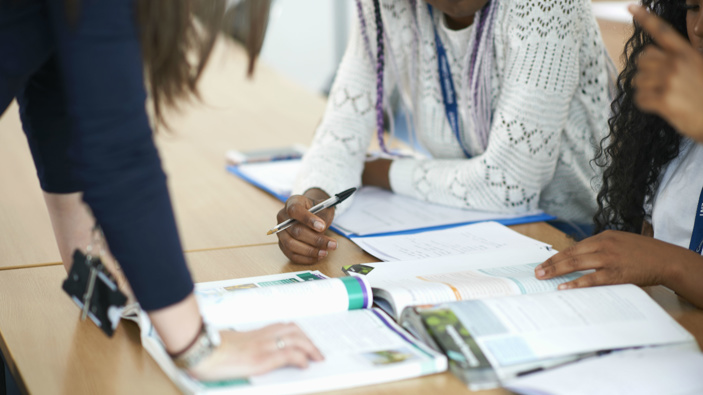Follow
the podcast on

Schools have been told to prepare to reopen for "some but not all" of their students on April 29 - but principals are still uncertain what reopening will look like.
The Ministry of Education has sent a bulletin to schools saying that "a hybrid model of both distance learning and on-site learning is very likely at least in the early stages" after the coronavirus lockdown ends.
"We want to reassure you that following any announcement, you will have some time to prepare for physically reopening your school or early learning service to welcome back on site your staff and some, but not all, of your children/students," it said.
Prime Minister Jacinda Ardern has said the Cabinet will decide next Monday, April 20, whether the lockdown will end as originally planned at midnight on April 22.
"Assuming the alert level does change, current planning assumptions are that you will have Thursday April 23 and Friday April 24 to fully access your site and undertake a property inspection and necessary maintenance and cleaning," the ministry has told schools.
"Monday April 27 is a public holiday (Anzac Day observed) and Tuesday April 28 will be a staff-only day.
"We therefore anticipate Wednesday April 29 would be your first day with some of your students/children able to attend in person. Early learning centres might not need all of this time."
Education Minister Chris Hipkins told TVNZ's Q&A that teachers might return to schools before their students.
"It may be that in the first instance they are able to come back into their classrooms and continue to provide remote learning from the school environment where they have access to broadband," he said.
"We do need to prepare for a number of scenarios, and one of those scenarios is that a significant number of young people could be at home for a long time after level 4 is lifted."
Once it was safe to let some children return to school, he said the children of essential workers were "clearly a priority" so that their parents could go to work.
"But it might not be everyone back at school at the same time," he said.
He said schools would still have to enforce "social distancing".
"That social distancing is really challenging in a school environment, and even more so in an early learning environment," he said.
"Timetables will be different. Some kids may be in school only part of the time and working from home some of the time."
Some teachers who were older or had health conditions making them more vulnerable to Covid-19 might still be working from home, and reopening could differ for different age groups.
"With students doing NCEA we know that social distancing is more possible. If you tell them to sit two metres apart they probably will," he said.
"On the other hand, with toddlers - not so possible."
These comments indicate that students' return may vary a lot between schools. Most schools reported that only "a couple of handfuls" of children turned up on the two days just before the lockdown when schools stayed open only for the children of essential workers.
Even in rural areas, where farmers are classed as essential workers, few turned up. Secondary Principals' Council chairman James Morris, principal of rural Darfield High School in Canterbury, said "essentially no students came in" on those last two days.
"Lots of them had someone who could look after them at home for that time, or they were old enough to look after themselves," he said.
He said it would be very difficult to provide normal classes only for children of essential workers.
"They would be scattered throughout the different classes. You would have an entire teaching workforce there with one or two people in each of the classes," he said.
He said another option of starting with NCEA students would also create problems because they were often caring for younger siblings at home.
And any move to teach some classes on different days, leaving students to work at home on the other days, would not reduce the risk of spreading the virus because students would be going home to mix with siblings in other classes.
Some schools will also be hit harder than others by staff who are older or otherwise at risk. Auckland Grammar was "down by 20 staff" on March 23, when people over 70 or with other at-risk health conditions were advised to stay home, and Morris said 5 to 10 per cent of teachers might need to stay home across the country.
He said a likely scenario was reopening schools region by region.
"I'm assuming they are only going to let students and staff come back when they are confident that, within particular communities, there is very low to zero incidence out there in the community," he said.
Principals' Federation president Perry Rush said it was clear that there would be "some sort of interim reality" after the lockdown ends before all schools and early childhood services reopen.
"That interim reality is anybody's guess, but there are a couple of potential cabs off the rank," he said.
"One could be, at level 3, a child of essential workers would be the most likely [to get back to school]. That would support some industry to be back in place in terms of releasing parents to go to work.
"The other obvious one is the potential for senior secondary, students engaged in national qualifications, to be back in front of teachers."
He said the 84 coronavirus cases associated with Auckland's Marist College showed the need to manage the reopening of schools carefully "for a period of time".
Hipkins said last week that contracts with TVNZ and Māori Television to operate educational TV from 9am-3pm daily from this Wednesday were for "at least a month at this stage but we have the ability to extend that if we need to".
Vocus, which owns the Slingshot and Orcon internet service providers, said its agreement with the Ministry of Education provided for six months of free broadband, with unlimited data, for 10,000 families of school-aged children who don't currently have home internet.
Chief executive Mark Callander said the first 2000 families would be connected this week. Hipkins has said 80,000 families need internet connections.
Ministry deputy secretary Ellen MacGregor-Reid told Parliament's emergency response committee that the ministry also aimed to provide 145,000 laptops and Chromebooks to families that don't have suitable devices for home-based learning.
"We have 17,000 devices. We estimate we need about 145,000, so we do need to prioritise devices as they become available," she said.
Take your Radio, Podcasts and Music with you








